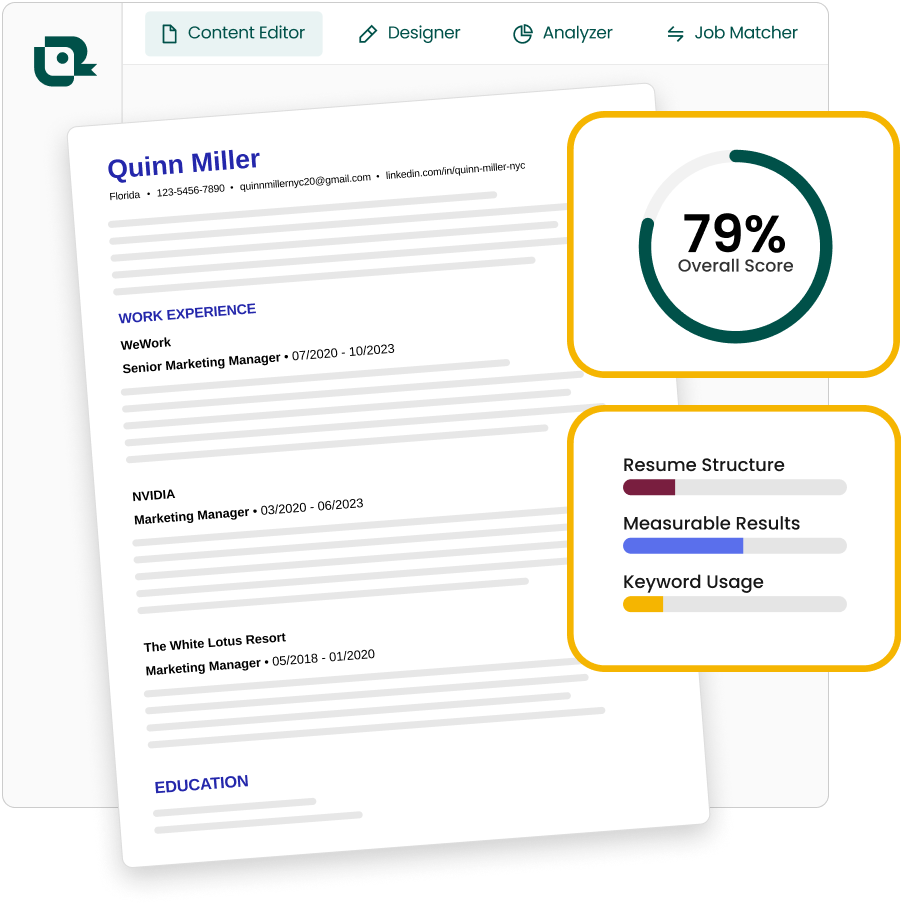3 key takeaways
- Learn to write a great one-page resume by homing in on relevance
- Discover how different one-page resume formats suit distinct needs
- Use our free one-page resume template to make a visually appealing document
One page might not sound like a lot, but when it’s used wisely, it can be all you need.
A good one-page resume highlights your most relevant skills, experiences, and achievements in a short, clear format—so hiring teams can quickly say, “This is the person we need.”
In this article, you’ll learn when to use a one-page resume, how it compares to other types of resumes, and how to write one that gets you noticed. You’ll also get a free template to start strong.
Why choose a one-page resume?
A good resume fits the expectations of the role and company you’re submitting it to. In some cases, that means a short and snappy one-page resume works better than a detailed overview of your career. As the Purdue Owl notes, “New college graduates and other entry-level job seekers tend to need a one-page resume.” Unless you have loads of achievements, recruiters will generally prefer a short document.
But there are no hard and fast rules. Ultimately, relevance to the job is the deciding factor for resume length. So, is one page or two pages the better fit for you? Use this quick comparison to help guide your decision:

Want to scale down? Here's is how to fit a two-page resume onto one page
Already have a two-page resume? Here’s what you can cut—without losing your competitive edge:
- Roles older than 10–15 years, unless they directly support the job you’re applying for
- High school education, if you’ve completed college or beyond
- Outdated tools, systems, and certifications. If it’s not in the job description—and not a strength—it’s not helping you.
- Generic responsibilities like “attended meetings” or “handled emails”
- Bullet points without key outcomes (e.g., percentage increases or decreases, profits made, money saved, time saved, etc.) in your Work Experience section
- Long bullet points—keep them to 1–2 lines maximum
- Soft skills included without evidence (such as “team player” or “ambitious”)
- Personal information, like your address, age, headshot, marital status, and hobbies
💡 Pro tip: Manually trimming your resume can feel tricky, especially if you’re worried about removing something that could help land your dream role. Teal’s Resume Builder helps you focus on what’s most relevant by highlighting top skills and achievements based on the job description, so you can cut confidently and keep what counts.
How to write a one-page resume in 8 steps
A solid one-page resume isn’t merely short and sweet—it’s specific. Every section should help answer one key question for the hiring team: “Is this person a good fit for this role?” That means tailoring each part of your resume to the role you’re applying for.
Here’s how to do that, step by step:
1. Start with your contact information
Place this at the top of the page. At a minimum, include:
- First and last name
- Professional email address (e.g., “[email protected]”)
- Phone number, including area code
- City and state (no need for a full address)
- LinkedIn profile URL (customized with your name, like “linkedin.com/in/emme-alvarez,” if possible)
You can also add:
- Pronouns (if you’re comfortable sharing)
- X (formerly Twitter) profile URL (only if you use it professionally)
✍️ Tailoring tip: Check if the job description asks for additional links, such as to your personal website, portfolio, or GitHub profile. If so, include those links here.
🚫 Don’t: Include your birthdate, marital status, or a headshot. These aren’t necessary and can introduce bias.
2. Add a target job title
This is exactly what it sounds like: the title of the job you’re targeting. Including it on your resume helps recruiters instantly see what role you’re after and can help your resume show up faster in applicant tracking system (ATS) searches.
✍️ Tailoring tip: Use the exact job title from the job ad if your experience supports it. For example, if the job is listed as “Head Recruiter,” use that, not “Senior Recruiting Manager.”
🚫 Don’t: List your current job title if it doesn’t fully reflect the job you want. For instance, “Customer Support Associate” won’t help if you’re applying for “Client Success Coordinator.”
3. Create a professional summary
A professional summary gives recruiters and hiring managers a quick overview of your experience and, more importantly, what you can do for them.
Keep it to 3–4 sentences and include:
- Your current or most recent job title or area of focus
- Years of relevant experience
- Notable industries or companies
- 1–2 key achievements, including measurable results (like percentages or dollar amounts)
✍️ Tailoring tip: Scan the job description for repeated words, phrases, and concepts. Does the company seem focused on innovation, sustainability, technology, etc.? What skills, tools, and responsibilities appear multiple times? Incorporate those into your professional summary.
🚫 Don’t: Mention experience or skills that don’t relate to this job. It’s tempting to sprinkle those in for extra impact, but doing so actually has the opposite effect, weakening your professional summary.
Example:
Senior lead marketer with 7+ years of experience leading high-impact campaigns in the SaaS and eCommerce spaces. Proven ability to increase lead generation by 40% through data-driven content strategies. Skilled in campaign execution, performance analytics, and stakeholder communication.
4. Detail your work experience
Your Work Experience section is the heart of your resume and needs to be concise, especially in a one-page format. Aim for 3–4 roles at most, and focus on achievements, not just tasks, to demonstrate your impact.
Each entry should include:
- Company name
- Position(s) held
- Location (or “Remote”)
- Start date
- End date (use “present” for your current role)
- One-sentence description of the company (optional but helpful if the company isn’t well-known)
- 3–5 bullet points focused on your achievements
✍️ Tailoring tip: Include roles and achievements that best match the job description, and list your most relevant bullet points first. For example, for a role requiring “client-facing experience” and “sales growth,” lead with, “Managed a portfolio of 15+ clients and increased annual revenue by 30% through upselling and relationship-building.”
You can do this manually by reviewing job posts line-by-line, or save time with Teal’s Job Description Match tool, which suggests bullet points aligned to specific job descriptions.
🚫 Don’t: Go too far back into your work history. Only include roles you’ve had within the last 10–15 years, unless they’re highly relevant.
Examples:
• Redesigned onboarding with a 6-person team, increasing 90-day retention by 40% in 4 months
• Led regulatory audit uncovering 12 risks, helping client avoid $1.1M+ in penalties
• Launched referral program that increased applicants by 20%, cut time-to-hire by 25%, and saved $60K
5. List your education
For each entry, include:
- Degree or diploma
- School and location
- Graduation date (optional)
✍️ Tailoring tip: Include only education details that align with your desired role. For instance, if you’re applying for a marketing position, highlight your business degree and relevant marketing coursework, but skip unrelated studies, such as an associate’s degree in marine biology.
🚫 Don’t: List incomplete qualifications without marking them as “in progress.”
Example:
Bachelor of Science, Business Administration
Pennsylvania College of Technology – Williamsport, PA
Date of completion: May 2021
6. Add your certifications
If the role calls for specific qualifications (and you have them), include a Certifications section.
All you need is the certification name and the organization that issued it. You can add the date of completion, but this isn’t required.
✍️ Tailoring tip: Use the same wording from the job description if it matches your certification. For example, if it mentions “CPR certification,” list yours as “CPR Certification – American Red Cross” rather than just “First Aid Training.”
🚫 Don’t: List expired certifications, even if they’re relevant. These take up limited space but add no value.
Example:
Google Analytics Individual Qualification (GAIQ) – Google
Certified ScrumMaster (CSM) – Scrum Alliance
7. Spotlight your skills
Create a Key Skills section that lists 8–10 skills aligned with the role.
✍️ Tailoring tip: Pull keywords directly from the job posting, and list the skills you actually have. (This helps your resume stand out in ATS tools, which often scan for words and phrases used in job descriptions.) For example, if it mentions “data analysis” and “SQL,” include those exact terms if they reflect your experience.
🚫 Don’t: Include soft skills that describe how you work and collaborate, like “team player.” Avoid buzzwords, and instead focus on hard skills: your technical knowledge and measurable abilities.
Examples:
• Project Management
• Budget Analysis and Forecasting
• Inventory Planning
• Market Analysis
• Agile and Scrum Methodologies
• Risk Mitigation
8. Include awards, publications, and other extras
If you have extra space and the content is relevant, you can add one or more of these sections to your one-page resume:
- Awards and Scholarships
- Projects
- Volunteering and Leadership
- Publications
✍️ Tailoring tip: Only add details that reinforce why you’re the best person for the specific job you’re after. Applying to a non-profit? Add your volunteer work. Seeking an academic role? Include your recent publications. Need to demonstrate your expertise and impact? Mention your awards.
🚫 Don’t: Add these sections without context. For projects, don’t just list titles—briefly explain what you did and what the outcome was. For awards, mention what the award was for, not just the name. Make sure each entry provides a clear, concise picture of what you accomplished and why it’s important.
💡 Pro tip: These eight steps are powerful, but doing them by hand for every job application can slow you down. Teal’s one-page resume builder speeds this up with tools that help you format, tailor, and refine your resume—all in one place.
Four other ways to format a one-page resume (and who each one is best for)
Your resume format is about how you organize your experience, while your layout is how it looks on the page (more on that in the next section).
A reverse-chronological order is common for resumes, but it isn’t your only option. Check out this and other formats that are excellent for one-page resumes:
Avoid these one-page resume layout mistakes
Even the best information can get lost in a cluttered or inconsistent layout. Here’s how to make sure your resume looks tidy from top to bottom:
- Use a professional, sans-serif font (e.g., Arial, Calibri, Helvetica).
- Stick to 11- or 12-point font for body text and 14- or 16-point font for section headers.
- Use one-inch margins (with 0.5-inch as the minimum).
- Space lines at 1.2–1.5x for readability.
- Left- or right-align your text. Centered text is harder to scan.
- Use bullet points (not paragraphs) for your achievements.
- Go light on bolded text. Use it to highlight job titles, key results, or companies.
- Use the same format for all dates (e.g., Jan 2023–Mar 2024).
- Be consistent with punctuation. For example, if one bullet has a period, they all should.
One-page resume checklist
Ready to attach your one-page resume to your job application? Before you do, review it against this checklist:
One-page resume template
Name: [First Name Last Name]
Phone: [Phone Number]
Email: [Email Address]
LinkedIn: [linkedin.com/in/your-link]
Location: [City, State]
Target Job Title and Professional Summary
[3–4-sentence summary listing your experience, industries, areas of expertise, and 1–2 achievements with numbers that show results, such as percentages or dollar amounts.]
Work Experience
[Job Title]
[Company Name] | [Location] | [Start – End Year]
[Company description (optional)]
• Increased [process or outcome] by [X]% through [tool or strategy], resulting in [impact].
• Led [project/team] to [result], contributing to [company goal].
• Streamlined [workflow/process], reducing [time/cost/errors] by [X]% through [method/tool].
[Your Job Title]
[Company Name] | [Location] | [Start – End Year]
• Improved [metric or performance area] by [X]% by implementing [solution or initiative].
• Managed [team/project/budget] and achieved [result or improvement].
• Collaborated with [department/partner] to [action], driving [outcome].
(Repeat for up to four roles, using fewer bullets for older roles.)
Education
[Degree], [Area of Study]
[School Name] – [Location]
(Optional) [Date of completion]
Certifications
[Certification Name] – [Issuing Organization]
[Certification Name] – [Issuing Organization]
Skills [8–10 hard skills that align with your target role.]
• [Skill 1]
• [Skill 2]
• [Skill 3]
Etc.
Sample one-page resume
.webp)
Frequently Asked Questions
What format is best for a one-page resume?
There’s no one “best” format for a one-page resume. What’s most important is to use clear headings, consistent spacing, and an easy-to-read font. Also, stick to bullet points, focus on achievements, and prioritize the most relevant experience. Lastly, avoid graphics or tables that can make it tricky for an ATS to read your resume correctly.
Is a one-page resume a myth in 2025?
A one-page resume is not a myth, but it's not a rule either. For early-career professionals, one page is often enough. Mid-to-senior level candidates can use two pages if the content is relevant and tailored. What matters most is clarity, impact, and alignment with the job, not page count.
Should I include a summary or objective on my one-page resume?
A professional summary is better than an objective for a one-page resume. It gives a concise overview of your experience, skills, and value, tailored to the role. For example, if the job emphasizes data analysis and cross-functional collaboration, your summary should highlight those strengths.
Is a one- or two-page resume better?
A one-page resume is typically better for recent graduates or entry-level employees. However, more seasoned candidates usually benefit from a two-page resume.
When should you write a two-page resume?
You should write a two-page resume if you have valuable experience from the last 10 years and can’t fit it into one page. Similarly, if you have extensive credentials or relevant philanthropic experience, a two-page resume is probably a better fit.





.jpg)


